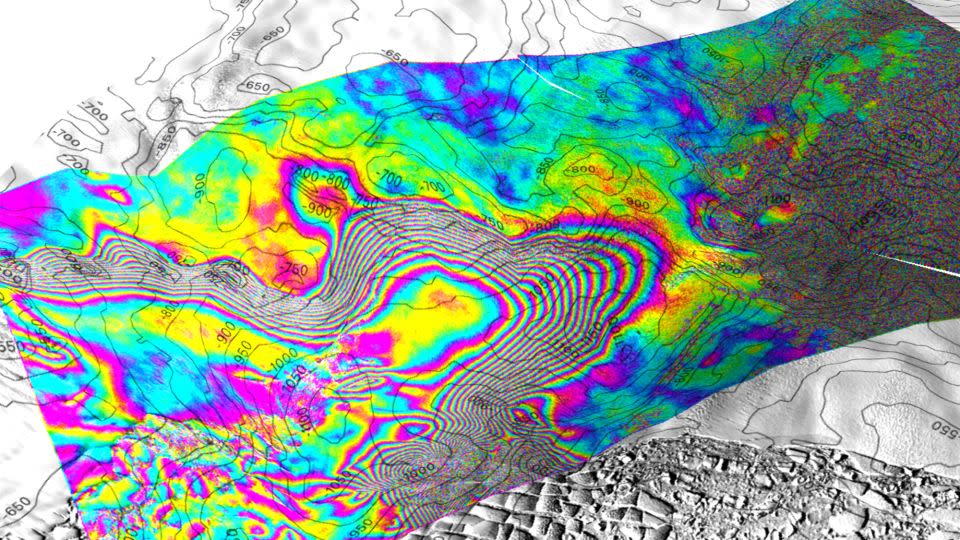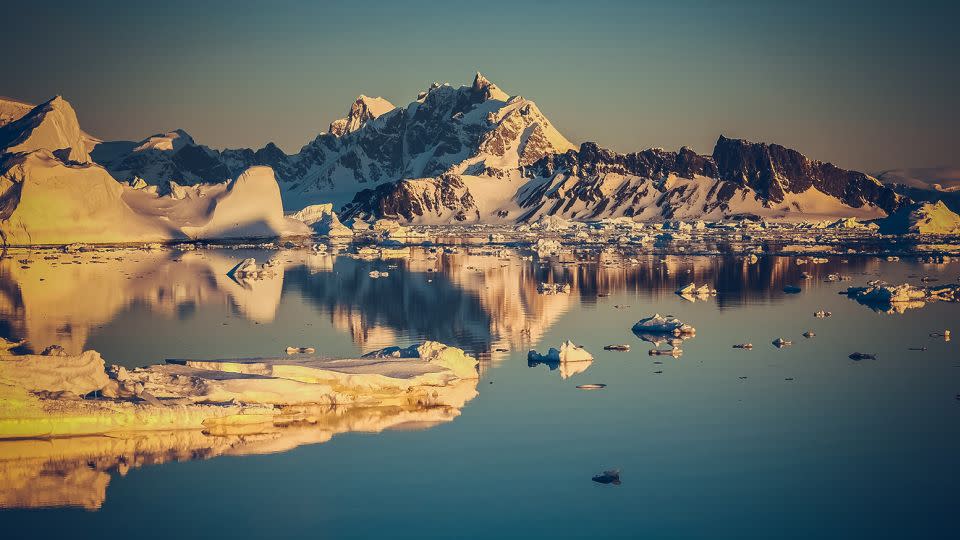Ocean water extends for miles beneath Antarctica’s ‘Doomsday Glacier,’ making it more vulnerable to melting than previously thought, according to new research that used radar data from space to take an X-ray of the crucial glacier.
When salty, relatively warm ocean water meets ice, it causes “vigorous melting” beneath the glacier and could mean sea level rise predictions are underestimated, the published study suggests Monday in the Proceedings of the National Academy of Sciences.
The Thwaites Glacier in West Antarctica – nicknamed the “doomsday glacier” because its collapse could cause a catastrophic rise in sea levels – is the largest glacier in the world and has roughly the size of Florida. It is also Antarctica’s most vulnerable and unstable glacier, largely because the land it sits on slopes downward, allowing ocean waters to eat away at its ice.
Thwaites, which already contributes 4% to global sea level rise, holds enough ice to raise sea levels by more than 2 feet. But because it also acts as a natural dam on the surrounding ice in West Antarctica, scientists have estimated that its complete collapse could ultimately lead to a rise in sea levels of around 3 meters, a catastrophe for the coastal communities of the world.
Numerous studies have highlighted Thwaites’ immense vulnerabilities. Global warming, caused by human burning of fossil fuels, has left it hanging “by its fingernails,” according to a 2022 study.
This latest research adds a new and alarming factor to the projections about its fate.
A team of glaciologists – led by scientists from the University of California, Irvine – used high-resolution satellite radar data, collected between March and June of last year, to create an x-ray of the glacier. This allowed them to chart changes in Thwaites’ “anchor line”, the point at which the glacier rises from the seafloor and becomes a floating ice shelf. Grounding lines are essential to the stability of ice sheets and are a key point of vulnerability for Thwaites, but they have been difficult to study.
“In the past, we only had sporadic data to look at this,” said Eric Rignot, professor of Earth system science at the University of California, Irvine and co-author of the study. “In this new data set, daily and over several months, we have robust observations of what is happening.”


They observed that seawater seeped under the glacier for several kilometers, then came out again, following the daily rhythm of the tides. When water enters, it only needs to “lift” the surface of the glacier a few centimeters, Rignot told CNN.
He suggested the term “grounding zone” might be more appropriate than stranding line, because it can move nearly 6 kilometers over a 12-hour tidal cycle, according to their research.
The speed of seawater, traveling considerable distances in a short period of time, increases the melting of glaciers, because as soon as the ice melts, fresh water is washed away and replaced by more seawater. hot, Rignot explained.
“This process of massive and widespread seawater intrusion will increase projections of sea level rise from Antarctica,” he added.
Ted Scambos, a glaciologist at the University of Colorado at Boulder who was not involved in the study, called the research “fascinating and important.”
“This finding yields a process that, until now, is not taken into account in models,” he told CNN. And even if these results only apply to certain areas of the glacier, he said, “this could accelerate the rate of ice melt in our forecasts.”
One uncertainty to be resolved is whether the influx of seawater beneath Thwaites is a new phenomenon or whether it is significant but long unknown, said James Smith, a marine geologist at the British Antarctic Survey, who did not participated in the study.
“Regardless, this is clearly an important process that needs to be incorporated into ice sheet models,” he told CNN.
Noel Gourmelen, professor of Earth observation at the University of Edinburgh, said using radar data for this study was interesting. “Ironically, it’s by going into space, using our growing satellite capabilities, that we learn a lot more about this environment,” he told CNN.
Many unknowns remain about what the study’s findings mean for Thwaites’ future, said Gourmelen, who was not involved in the research. It’s also unclear how widespread this process is around Antarctica, he told CNN, “although it’s very likely it’s happening elsewhere as well.”
A change of diet
Antarctica, an isolated and complex continent, appears increasingly vulnerable to the climate crisis.
In a separate study, also published Monday, researchers from the British Antarctic Survey examined the reasons for record levels of sea ice surrounding Antarctica last year.
By analyzing satellite data and using climate models, they found that this record high would have been “extremely unlikely without the influence of climate change.”


Melting sea ice does not directly affect sea level rise because it is already floating, but it leaves coastal ice sheets and glaciers exposed to waves and warm ocean waters, making them much more vulnerable to melting and breaking.
The researchers also used climate models to predict the potential speed of recovery from such an extreme loss of sea ice and found that even after two decades, not all the ice would return.
“The impacts of keeping Antarctic sea ice low for more than twenty years would be profound, including on local and global weather,” Louise Sime, co-author of the BAS study, said in a statement. .
These findings add to evidence in recent years that the region is facing “sustainable regime change,” the authors write.
For more CNN news and newsletters, create an account at CNN.com